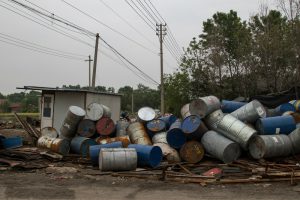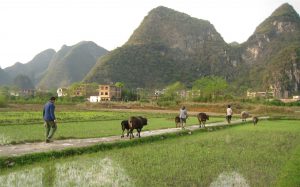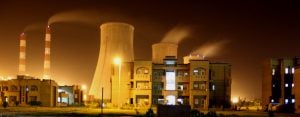When students at the new Changzhou foreign language school started complaining about headaches and skin problems in 2016, the contamination of the local soil would soon become one of China’s most high profile scandals. The students fell ill when the effort to remediate soil polluted by a chemicals factory spread it further afield.
There’s no law governing soil pollution in China but a string of high profile pollution cases over the past decade has spurred the government to act.
On 1 January the Law on the Prevention and Control of Soil Pollution will come into effect. This is a stronger version of a 2016 soil pollution action plan. It includes more detail on holding soil polluters accountable and adopts a protection-first and polluter-pays approach. Additional rules on implementation will be needed if the law is to be effective, but it has clarified the government’s approach to soil management and should prevent another scandal like that in Changzhou.
An invisible problem
Unlike water and air pollution, soil pollution is often invisible and decades can pass between when the pollution occurs and the problem becomes apparent, says Chen Tongbin, director of the Centre for Environmental Remediation at the Chinese Academy of Sciences’ Institute of Geographic Sciences and Resources Research.
In the Changzhou case, the land was formerly used by companies manufacturing chemicals and fertiliser. By the time the pollution was detected, the original firms had long since been restructured and merged with others and moved to other sites, making it impossible to identify who was responsible.
The company that did the remediation planned to remove the polluted soil and replace it. However, the removal process was botched, releasing toxic chemicals trapped in the soil in the form of noxious gases.
“Soil pollution gets the least attention, but results in frequent scandals, as soil is closely linked to human health,” says Zhang Boju, secretary-general of environmental group Friends of Nature.
The accumulation of soil pollution is connected with intensive mining and use of fertilisers during four decades of rapid economic growth.
You’ve got to know what the problems are before you can tackle themZhang Boju, Friends of Nature
In April 2014, the Ministry of Environmental Protection and the Ministry of Land and Resources jointly published a national soil survey. It concluded that China’s soil environment was not good, with serious pollution in some areas, worrying environmental quality of arable land, and particular issues with pollution of former mining and industrial sites. According to the survey, 16.1% of soil samples collected from around the country showed evidence of pollution.
The problem will be complex and costly to deal with. The government must consider how to stop soil quality worsening, and tackle pollution that is both hidden and spread over vast areas. It must also clarify responsibility for cleaning it up, decide where the money will come from to do this, and what technologies should be used.
These problems were perfectly illustrated by the situation in Changzhou: the original polluters had moved on, inappropriate remediation techniques were used, and the environmental impact report was deeply flawed. The new soil law must solve these issues if it is to make a difference.
Who is responsible?
“In the past, the people using the land had very little awareness of soil protection and remediation. Once a project’s environmental impact assessment was accepted you could rest easy,” says Ge Feng, an environmental lawyer and director for legislation and policy advocacy with Friends of Nature.
“There’s no basis on which to assign responsibility for pollution arising during production and development, and usually whoever is using the land can pollute it without any consequences,” adds Ge.
The new law should change this as it clarifies responsibility for the prevention and management of soil pollution. The law establishes 13 types of responsible party, including those demolishing buildings or industrial facilities; operators and managers of mine tailing ponds; the producers, retailers and users of fertiliser; soil remediation firms; land owners and local government. Each has its own legal responsibilities. If there is dispute over who is responsible in a particular case, the new law allows relevant local government departments to make a determination.
In this way, a responsible party can be identified when soil is polluted, and the risks of potential pollution when a site is to be developed are to be shared between regulators and the developer. The law stipulates that a pollution risk assessment must be obtained before a site is used. Polluting activities must also be minimised when land is in use, and remediation must not cause secondary pollution.
Risk management
The new law puts prevention and protection first. Gao Shengda, executive editor of China Remediation, an environmental remediation website, says: “If sources of pollution aren’t shut down, it is neither rational nor economic to blindly press ahead with remediation, production or construction.”
The new law also makes local governments responsible for creating and maintaining lists of soil pollutants, key soil pollution regulators, and construction and remediation risks with specific sites. As Zhang says: “You’ve got to know what the problems are before you can tackle them.”
The new law continues with the action plan’s method of categorisation, with both agricultural and building land divided into several types, each managed differently, according to the degree of pollution and nature of land use. Unpolluted and polluted land are treated differently, with targeted measures to either protect, control or remediate, as appropriate.
Zhong Bin, deputy head of the Ministry of Ecology and Environment’s (MEE) soil department, said in an interview with Chinese news site thepaper.cn that polluted soil can be sealed off, unlike polluted air. If polluted sites cannot be economically restored, a risk management approach can be taken to prevent pollution affecting human health through agricultural products or other routes.
In July, the MEE published standards for management of pollution risks on agricultural and building land, in cooperation with the State Administration for Market Regulation, providing specific requirements for the monitoring, use and supervision of these sites. Consultation drafts of other standards, including regulations for the management and remediation of polluted arable land, are in circulation.
A Chinese superfund?
But funding to clean up so many polluted sites is not in place – spending on soil remediation in China accounts for less than 1% of the environmental protection sector as a whole. Though the new law will make it clear who is responsible for paying for future pollution to be cleaned up, there are many existing sites where responsibility cannot be determined.
These funds will be set up at both central and provincial level, to tackle pollution of agricultural land and sites. However, although the fund mechanism is included in the law, further work is needed to determine how it would function Gao points out.
In the United States, which has ample experience of managing polluted sites, a “superfund” is used to ensure remediation is carried out. It is funded by the government, via a tax on potentially polluting firms and fines imposed on companies or individuals found to have harmed the environment.
Just the existence of the law is a breakthroughCao Zuonan, University of Tuebingen
The new law does not say where the money for the funds will come from, but that rules for the management of the fund will be produced by the State Council in cooperation with the ministries and authorities governing environmental protection, agricultural and rural issues, natural resources, housing and construction, and forestry.
Such a fund would be good news for the remediation of agricultural land. Recent research from the Chinese Academy of Sciences shows that 21% of points tested on China’s grain growing land had excessive levels of heavy metals, with 5% classed as heavily polluted, and not one key grain-producing area free of all pollution. Agriculture does not bring in enough money to cover the huge costs of cleaning up that soil, but the fund could make up the shortfall.
Transparency signals
A lack of transparency meant that in the past, the Chinese public remained unaware of serious and long-standing soil pollution issues. In 2005, the Ministry of Environmental Protection and the Ministry of Land and Resources started an eight-year nationwide survey of soil pollution – only for the MEP to refuse to release the data and methodology used, describing them as “state secrets”. The survey cost one billion yuan (US$144 million) and the failure to publish the data has come in for fierce criticism.
The new law will see the creation of a system for sharing soil environmental information. This may finally make information on soil pollution available to the public.
National surveys of soil pollution will become regular events as the new law requires one at least every decade. Zhong Bin told thepaper.cn that the findings of the surveys would be made public. But he also pointed out that the location of specific testing sites would not be revealed to prevent interference with the survey through site-specific remediation.
These comments from an official responsible for soil pollution indicate that China’s efforts to tackle the problem face complex challenges. But Cao Zuonan, of the Department of Geosciences at the University of Tuebingen in Germany, says: “Just the existence of the law is a breakthrough. It’s a new start for the prevention, control and remediation of soil pollution in China and worth looking forward to.”









